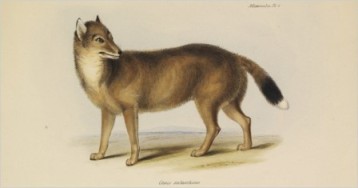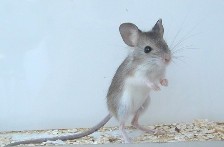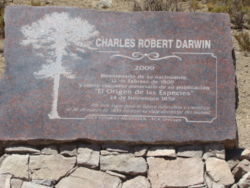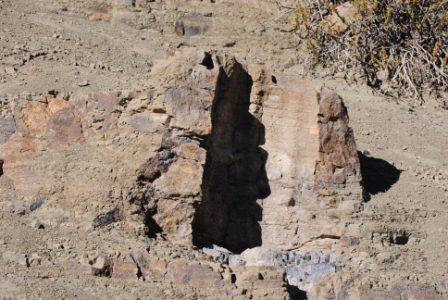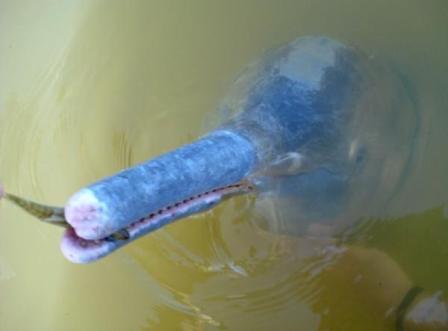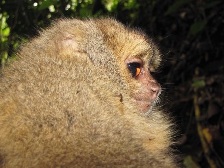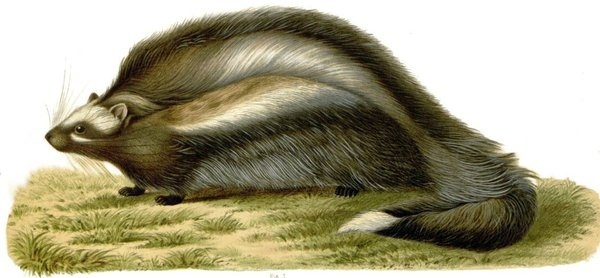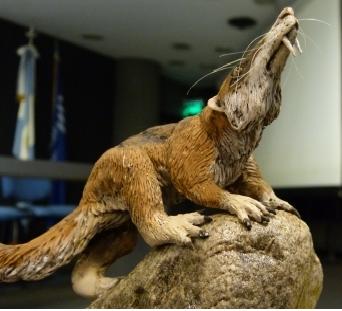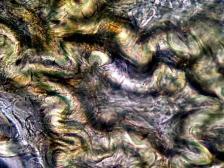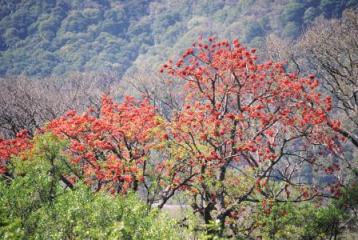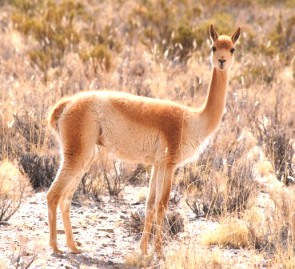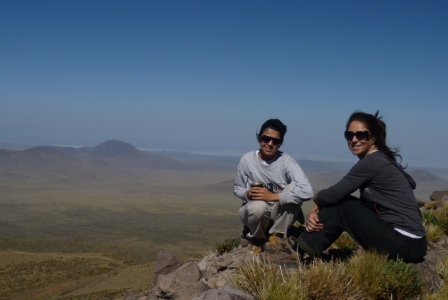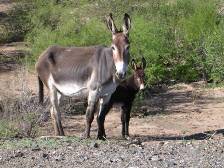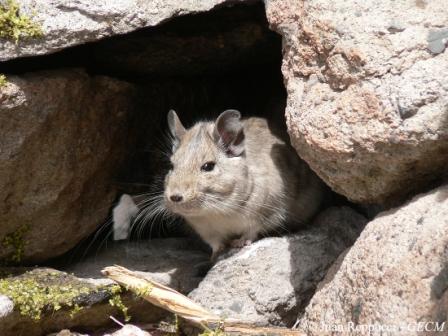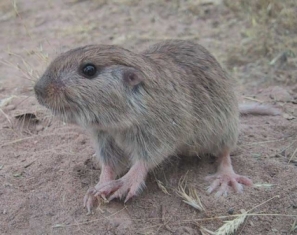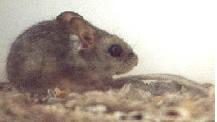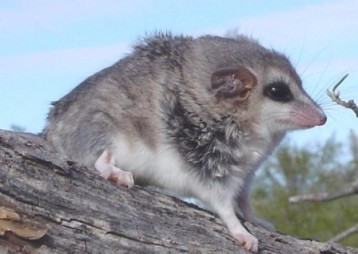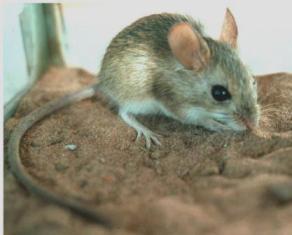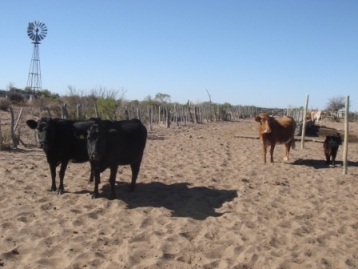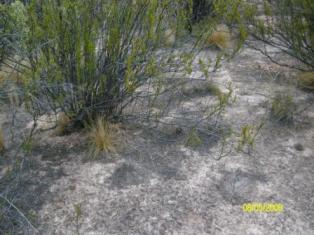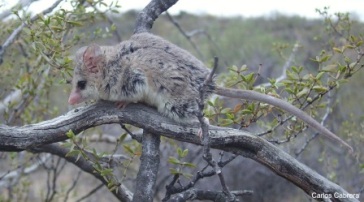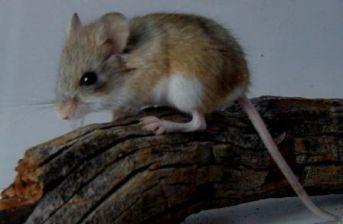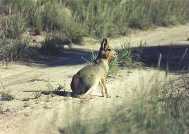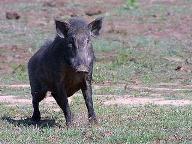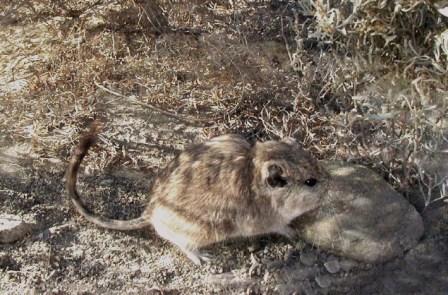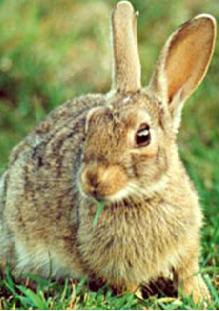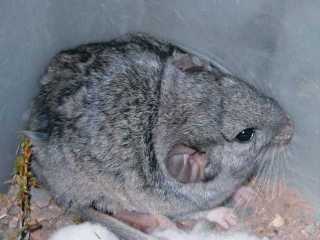|
|
|
|
2016 - XXIX JORNADAS ARGENTINAS DE MASTOZOOLOGIA, SAN JUAN
La Comisión Organizadora Local y la Comisión Directiva de la Sociedad Argentina para el Estudio de los Mamíferos, tienen el
agrado de invitarlos a participar de las XXIX Jornadas Argentinas de Mastozoología a desarrollarse del 18 al 21 de Octubre de 2016
en la ciudad de San Juan, Argentina
BIOLOGY OF CAVIOMORPH RODENTS: DIVERSITY AND EVOLUTION
[1]
LA GRAN BARRERA DE CORAL EN PELIGRO [2]
TIMETREE
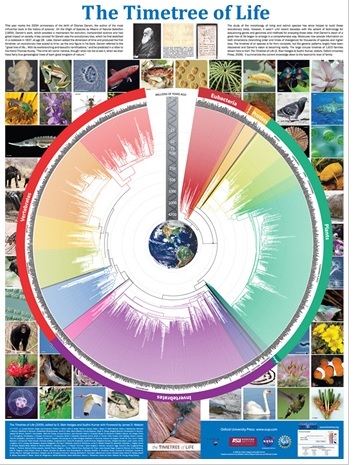
TIMETREE is a public resource for knowledge on the timescale and evolutionary history of life. Search the database below or go to the TIMETREE OF LIFE for other resources.
[3]
SOCIOBIOLOGY OF CAVIOMORPH RODENTS: AN INTEGRATIVE APPROACH
2017 - CONGRESO NACIONAL DE CONSERVACION DE LA BIODIVERSIDAD
La Escuela Superior de Ciencias Marinas (ESCiMar), el Centro de Investigación Aplicada
y Transferencia Tecnológica en Recursos Marinos “Almirante Storni” (CIMAS), en
representación de sus instituciones patrocinantes y en conjunto con la Fundación de
Historia Natural Félix de Azara, tienen el agrado de invitar al “V Congreso Nacional de
Conservación de la Biodiversidad” que se llevará a cabo entre los días 19 y 22 de
septiembre de 2017, en la localidad de Las Grutas, Río Negro, Patagonia Argentina.
Se invita a investigadores, tomadores de decisión, miembros de organizaciones
gubernamentales y no gubernamentales, estudiantes y toda persona o institución
vinculada a temas de conservación y uso de la biodiversidad a participar activamente en
esta reunión que se celebrará el año próximo.
Sobre la compleja ECOLOGIA DE LAS ENFERMEDADES INFECCIOSAS EMERGENTES, los cambios ambientales y los desafíos para un mejor entendimiento de las relaciones hombre-animales - degradación ambiental - enfermedades infecciosas
[4]
EL TEATRO ECOLOGICO Y EL DRAMA EVOLUTIVO
[5]
NOTICIAS AMBIENTALES [6]
FRIENDS OF CHARLES DARWIN[http://friendsofdarwin.com/misc/buttons/
La pérdida de mamíferos del Gran Chaco Sudamericano y sus consecuencias
[7]
Genome expansion in vizcacha rats
[8]
Ecología de un invasor y la práctica de la biología de la conservación
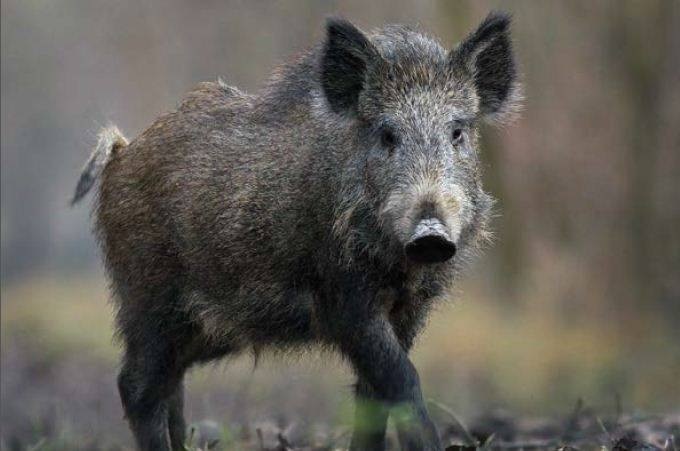
El jabalí europeo integra la lista de “las 100 peores especies exóticas invasoras del mundo ”
(http://www.issg.org/database/species/search.asp?st=100ss).
Es uno de los mamíferos terrestres de mayor rango geográfico. La especie se encuentra ampliamente distribuida en Europa, Asia y norte de África. Entre los años 1904 y 1917 la especie fue introducida en las provincias argentinas de La Pampa y Neuquén, y actualmente se encuentra en la mayoría de los Parques Nacionales de Argentina.
El jabalí es un mamífero invasor que genera alteración del hábitat, depredación sobre distintos vertebrados e invertebrados, competencia con otras especies, dada su capacidad de dispersión y amplia dieta, entre otros.
La reciente investigación de Ballari et al., sobre la ecología trófica del jabalí en el Parque Nacional El Palmar (Provincia de Entre Ríos, Argentina) mostró que su espectro dietario está asociado a los cambios estacionales, detectándose principalmente restos de aves, como palomas, y frutos. Estos últimos principalmente en la estación de verano. Asimismo evaluaron el papel del maíz, utilizado como cebo para atraerlos y cazarlos en el marco del plan de manejo dentro del Parque Nacional. Los autores del estudio consideran que la provisión constante de maíz constituye un excelente suplemento a la dieta, cuyos resultados se traducen en una mejor capacidad reproductiva de la especie, incremento poblacional y en consecuencia, mantenimiento del impacto del jabalí sobre la dinámica ecosistema. Los investigadores recomiendan aplicar otros métodos de control, como la caza con perros, trampas y el uso de cebos alternativos al maíz, como cebos de olor (S. A. Ballari
& M. F. Cuevas & R. A. Ojeda & J. L. Navarro. Diet of wild boar (Sus scrofa) in a protected area of Argentina: the importance of baiting. Mammal Research (ex Acta Theriologica). En prensa
BIOLOGIA DE LA CONSERVACION
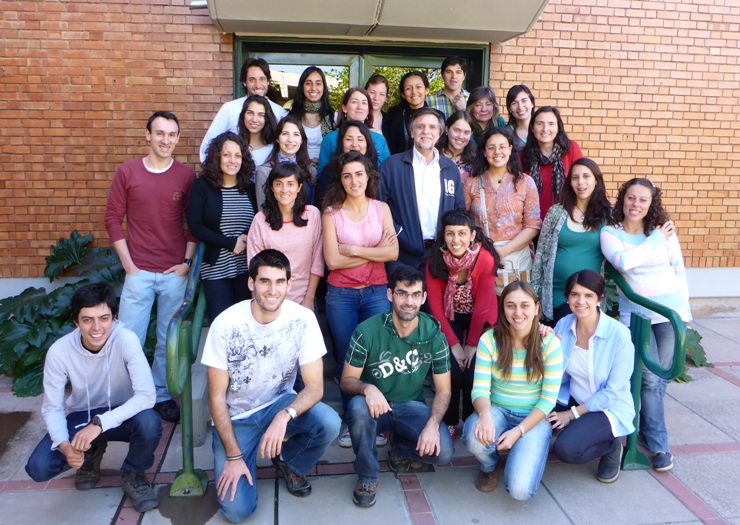
La biología de la conservación ha sido definida como una ciencia multidisciplinaria en tiempos de crisis, fundamentalmente por la acelerada pérdida de biodiversidad provocada por las actividades del hombre. De aquí que algunos hayan propuesto el nombre de Antropoceno al período geológico iniciado por el hombre en los últimos 10.000 años.Esta es la problemática que investigadores y becarios del IADIZA e IMBECU estarán tratando en uno de los cursos avanzados del CCT-CONICET-MENDOZA, durante la semana del 15 al 20 de setiembre. El mismo está orientado a proveer de conceptos, teoría, bases prácticas y herramientas científicas para la conservación y manejo de la diversidad biológica dentro de un contexto social, económico y político complejo.
Entre los temas a discutir por los profesores Agustina Ojeda, Fernanda Cuevas, Verónica Chillo, Agustina Novillo, Mariella Superina y Ricardo Ojeda se destacan los referidos a las bases biogeográficas –macroecológicas de la conservación, y sus implicancia frente a distintas amenazas como pérdida y modificación de hábitats, cambio climático y otras; la ecología de las perturbaciones, invasiones biológicas, genética de la conservación, criterios y clasificación de especies amenazadas, entre varios otros tópicos. La discusión de artículos y desarrollo de proyectos por los propios estudiantes, completan el intenso programa de este curso de posgrado.
Dinámica de ecosistemas áridos frente a distintas intensidades de pastoreo y estrategias de manejo ganadero[9]
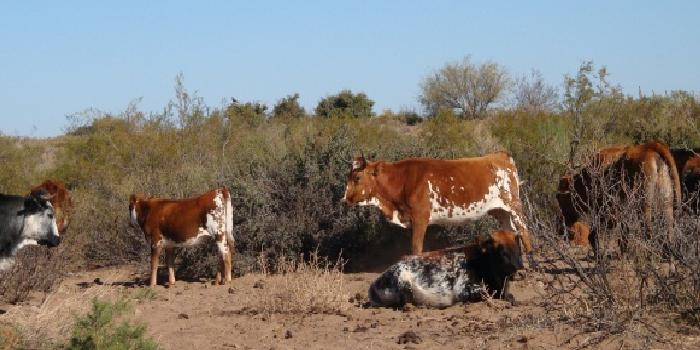
El objetivo general del trabajo fue analizar la dinámica del desierto del Monte Central bajo pastoreo vacuno en el marco del modelo de estados y transiciones. Para esto analizamos un gradiente continuo de intensidad de pastoreo y diferentes estrategias de producción ganadera (continuo vs. rotación), considerando varios componentes de la biodiversidad (vegetación, hormigas, pequeños mamíferos) y sus variaciones a lo largo de cambios estacionales en las precipitaciones y temperatura, abarcando así la heterogeneidad del ecosistema de desierto y del disturbio.
Entre los principales resultados publicados se muestra que la resiliencia de los procesos de ciclado de nutrientes y formación y retención del mantillo disminuye ante la intensificación en el disturbio por pastoreo. Esta pérdida de la capacidad del ecosistema de absorber el disturbio y reorganizarse puede promover la ocurrencia de estados degradados dados por la pérdida de productividad y de diversidad . Este cambio puede darse cuando el sistema excede un umbral (ej. respuesta no lineal al disturbio) y se alteran los mecanismos de retroalimentación que mantenían la estructura y función previa al disturbio. Sin embargo, no todos los ensambles presentaron un cambio brusco a lo largo del gradiente de intensidad de pastoreo.
Para la fauna en particular, la riqueza y la diversidad de hormigas y pequeños mamíferos mostraron cambios abruptos a baja intensidad de pastoreo. Incluso durante la estación húmeda, cuando hay mayor disponibilidad de recursos alimenticios y de hábitat, las poblaciones siguieron presentando un cambio brusco en el gradiente de disturbio. Queda por evaluar si la ocurrencia de eventos mayores de precipitación inter-anual (ej. El Niño-Oscilación del Sur) pueden generar una transición mayor, hacia estados restaurados de la diversidad. Por otro lado, y contrario a lo esperado, la vegetación no mostró una respuesta tan marcada como la fauna, y solo se vieron cambios bruscos en algunos componentes estructurales de la vegetación durante la estación seca y bajo pastoreo continuo. Finalmente, a pesar de que la respuesta de la composición de la vegetación al gradiente de disturbio no fue consistente, la tasa de descomposición sí mostró la ocurrencia de un umbral marcado en ambas estrategias de producción ganadera y a poca intensidad de disturbio. Esto puede darse porque aunque la relación entre estructura y función sea conocida es probable que sea inconsistente en espacio y tiempo, por lo que pequeños cambios en la estructura pueden generar grandes cambios en el proceso.
At the edge of what we know[10]
El ser humano desencadena la sexta extinción masiva del planeta[11]
Sobre el Impenetrable chaqueño [12]
Mapeando la Biodiversidad Mundial[13]
MANUAL DE FOTOTRAMPEO [14]
MAPA MUNDIAL DE DEFORESTACION [15]
Día Mundial de la Naturaleza[16]
Libros de la Sociedad Argentina para el Estudio de los Mamíferos [17]
Sobre investigaciones en pichiciegos [18]
FACEBOOK IADIZA - CONICET[19]
NEWS ARTICLES ON SPECIES DISCOVERY [20]
Ricardo Ojeda es el nuevo Presidente de la Federación Internacional de Mastozoología [21]
CURSO POSGRADO: EVALUACION INTEGRADA DE TIERRAS SECAS 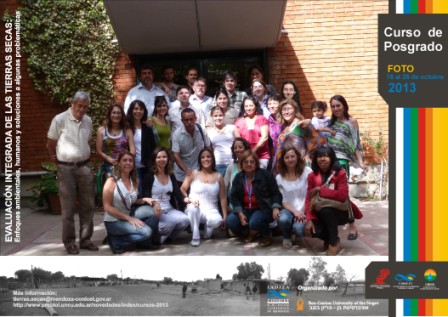
PRESENTACIONES RECIENTES
Ungulates of the Gran Chaco: regional status assessment and case studies
Alterations in fire regimes and accelerated changes in the Gran Chaco have resulted in a land use mosaic with bare soil and shrub encroachment. Moreover, hunting and habitat loss increasingly threaten the functional diversity of mammals by jeopardizing the animals themselves as well as the ecosystem services they provide. At a national level, of the nine native ungulates found in the Gran Chaco, three species are considered Endangered, two are Vulnerable, two are Near Threatened, and two are Least Concern. Specifically, we present diet and habitat use of the grey brocket deer (Mazama gouazoubira) and collared peccary (Pecari tajacu) in six land use configurations in the arid Chaco. Our results indicate that the brocket deer selects sites within primary and secondary forest, and avoids sites with mixed and Larrea shrublands. Peccary signs, on the other hand, were only found in primary forest. Both animals avoided logged pastureland and cultivated crops (Maria.E.Periago,Uni.Nacional de Córdoba, Verónica Chillo,y Ricardo.A.Ojeda , Grupo de Investigaciones de la Biodiversidad, Mendoza, Argentina; IMC 11,Agosto 2013,Belfast, Irlanda del Norte).
Biogeographical and ecological diversification of caviomorph rodents
The New World hystricognath rodents (Caviomorpha) probably came from Africa and diversified into major clades during the Eocene-Oligocene. We address the biogeographical and ecological diversification of caviomorphs within a recent phylogenetic framework. Our main results show that: a) The Amazonia and the Atlantic forest are the macrohabitats with the highest species density; b) species richness is associated with area and productivity; and, c) the extraordinary diversity of biogeographical and ecological attributes of extant superfamilies result from the diversification of ancestral character states. The most likely ancestral macrohabitat in the history of their diversification appears to be the Amazonia; whereas for the reconstruction of ecological characters (macroniches), our analysis hypothesized a saxicolous proto-caviomorph that fed on grasses, leaves and seeds. Our contribution highlights that caviomorph rodents serve as a good model for integrating and disentangling the roles of phylogeny, biogeography and ecology (Ricardo A.Ojeda, Agustina A.Ojeda, y Agustina Novillo, IADIZA-CONICET, Mendoza, Argentina; IMC 11,Agosto 2013,Belfast, Irlanda del Norte).
Is the desert marsupial Thylamys pallidior another semelparous species? Studies on marsupials show that species inhabiting seasonal environments synchronize their breeding season with the most favorable time of the year. An extreme expression of this strategy is semelparity. Although rare among mammals, it has been described in some dasyurid and didelphid marsupials. The aim of this study was to characterize the reproductive strategy of the desert mouse opossum by analyzing its population structure and response to environmental seasonality. We analyzed data from live-trapping during 3 periods in Ñacuñán Reserve (Mendoza, Argentina): 1984-88, 2005-07 and 2011-13. In all cases, captures showed seasonality in population structure. We found evidence of generation replacement with young animals occurring in summer (high resource availability). Reproductive females were trapped in spring and early summer. Almost no recapture exceeded 1 year. If we consider iteroparity - semelparity as a gradient, we suggest that this species is much nearer to a semelparous strategy (Soledad Albanese, Andrea Astié, y Ricardo A. Ojeda; IMC 11,Agosto 2013,Belfast, Irlanda del Norte.
Hasta siempre Jorge Morello...
Se fue uno de los grandes de la biogeografía y ecología de tierras áridas, y el primer Presidente de la Asociación Argentina de Ecología. Un gran hacedor, con una visión global integrativa poco común...
Su libro, "Él libro", "La Provincia Fitogeográfica del Monte" constituye un hito en el modo de entender nuestros ecosistemas y ha marcado
el camino de cientos de profesionales en distintas disciplinas, ecología, biogeografía, botánica y geografía...
Aquí van algunas de sus reflexiones sobre el avance de la agricultura, principalmente soja, en el chaco:
http://www.youtube.com/watch?v=wva-MCnFeVA#t=61
Una de cada cinco especies de mamíferos de Argentina se encuentra amenazada [22]
Pérdida de hábitat: el Gran Chaco y sus mamíferos [23]
Cambio climático, escenarios y pérdida de biodiversidad[24]
Nuestros Primos lejanos[25] 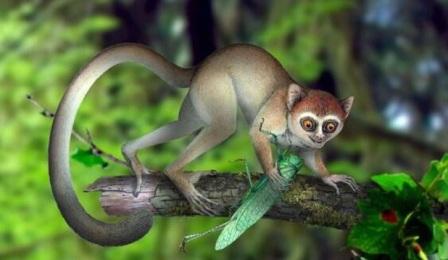
BIODIVERSIDAD DE ÑACUÑAN[26]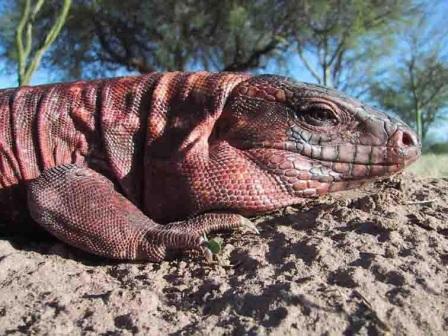
El top 10 de especies descubiertas en 2012[27]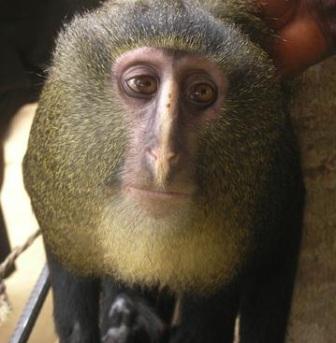
ESSENTIAL POINTS FOR POLICY MAKERS: Scientists’ Consensus on Maintaining Humanity’s Life Support Systems in the 21st Century[28]
Early bird beat Archaeopteryx to worm by 10m years[29]
Nuevo estudio muestra que los gases de clorofluorocarbonos son mas importantes que el dióxido de carbono en
el calentamiento global[30]
BIODIVERSIDAD ANDINA Y CAMBIO CLIMÁTICO [31]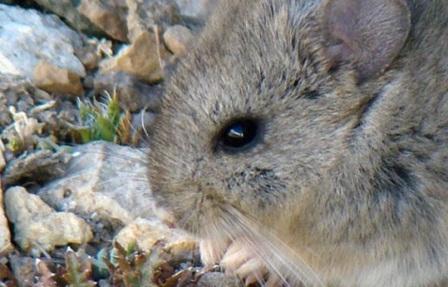
DIVERSITY AND CONSERVATION OF NEOTROPICAL MAMMALS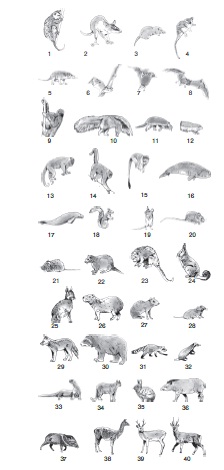
The Neotropical Region is one of the major biogeographic divisions for both plants and animals on Earth. It spans from central Mexico and the Caribbean islands to southern South America. This chapter provides an overview of the current state of our knowledge regarding the mammals of the Neotropical Region, including relevant geological events, evolution, biogeographic patterns, and large-scale assessment of threats, conservation status and prospects.
Keywords: Great American Interchange; Mammal diversity; Neartic-Neotropical Transition; Neotropical conservation; Neotropical mammals; Neotropical Region; South American mammals; Threats to mammals.
(Ojeda, R.A. 2013. In: Levin S.A. (ed.) Encyclopedia of Biodiversity, second edition, Volume 2, pp. 582-594. Waltham, MA: Academic Press) pdf
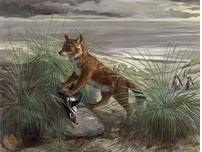 Desentrañando el misterio del zorro de Malvinas[32]
Desentrañando el misterio del zorro de Malvinas[32]
Lagartos en la Payunia, Mendoza, Argentina[33]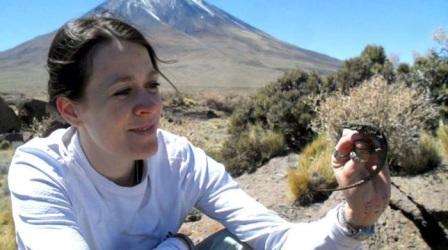 [34]
[34]
Widespread Local Extinctions in Tropical Forest remnants[35]
WALLACE ONLINE[36]
Wallace Online is the first complete edition of the writings of naturalist and co-founder of the theory of evolution Alfred Russel Wallace.
FISIOLOGIA ECOLOGICA Y CAMBIO CLIMATICO[37]
ANCESTOR OF ALL PLACENTAL MAMMALS REVEALED[38]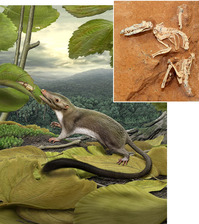
2012 EL AÑO MAS CALIENTE[39]
LAS NUEVAS REGIONES ZOOGEOGRAFICAS[40]
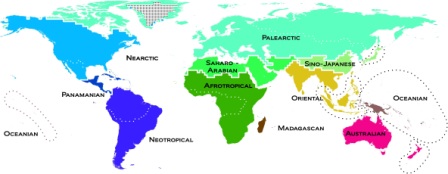
DIVULGACION
El manejo sustentable revaloriza la producción local y contribuye a la conservación de la vicuña[41]
The beginning of the armadillos [42]
ENCYCLOPEDIA OF BIODIVERSITY...the 2013 new edition
The science of biodiversity has become the science of our future. It is an interdisciplinary field spanning areas of both physical and life sciences. Our awareness of the loss of biodiversity has brought a long overdue appreciation of the magnitude of this loss and a determination to develop the tools to protect our future. The 7-volume Encyclopedia of Biodiversity, Second Edition maintains the reputation of the highly regarded original, presenting the most current information available in this globally crucial area of research and study. It brings together the dimensions of biodiversity and examines both the services it provides and the measures to protect it. Major themes of the work include the evolution of biodiversity, systems for classifying and defining biodiversity, ecological patterns and theories of biodiversity, and an assessment of contemporary patterns and trends in biodiversity. This encyclopedia is a worthwhile investment for anyone in need of a scholarly reference source devoted to biodiversity and related preservation issues. There are not other current encyclopedias that provide comprehensive in-depth coverage of this increasingly important topic.
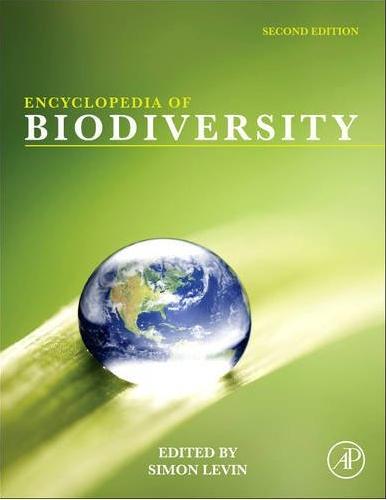
The revised edition includes over 100 new articles and 226 updated articles covering this multidisciplinary field - from evolution to habits to economics in 7 volumes * The editors for this second edition are all well respected, instantly recognizable academics operating at the top of their respective fields in biodiversity research--readers can be assured that they are reading material that has been meticulously checked and reviewed by experts. * Approximately 1,800 figures and 350 tables complement the text, and more than 3,000 glossary entries explain key terms
Encyclopedia of Biodiversity, Five-Volume Set: Encyclopedia of Biodiversity, Second Edition, Simon A Levin (Editor)
40 AÑOS DEL IADIZA [43]
LIBRO ROJO DE LOS MAMIFEROS AMENAZADOS DE LA ARGENTINA/ Argentina Red List of Threatened Mammals 2012
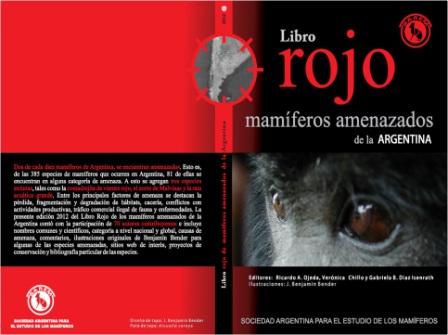
Dos de cada diez mamíferos de Argentina, se encuentran amenazados . Esto es, de las 385 especies de mamíferos que ocurren en Argentina,
81 de ellas se encuentran en alguna categoría de amenaza. A esto se agregan tres especies extintas , tales como la comadrejita de vientre rojo,
el zorro de Malvinas, y la rata acuática grande.
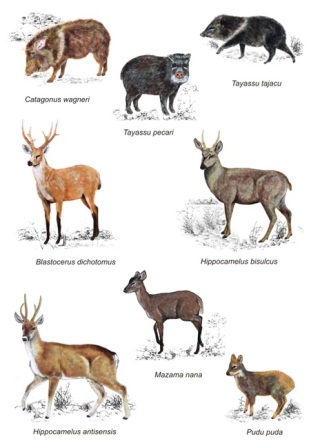
Entre los principales factores de amenaza se destacan la pérdida, fragmentación y degradación de hábitats, cacería, conflictos con actividades productivas, tráfico comercial ilegal de fauna, y enfermedades. La presente edición 2012 del Libro Rojo de los mamíferos amenazados de la Argentina contó con la participación de 70 autores contribuyentes e incluye nombres comunes y científicos,categoría a nivel nacional y global, causas de amenaza, comentarios, ilustraciones originales de Benjamín Bender para algunas de las especies amenazadas, sitios web de interés, proyectos de conservación,
y bibliografía particular de las especies.
Interesados contactar a Ricardo Ojeda en el IADIZA, CCT Mendoza (rojeda@mendoza-conicet.gob.ar), o David Flores: davflor@gmail.com
Algunos ejemplos de mamíferos amenazados…
ORDEN PILOSA
M. Superina, A. M. Abba y S. F. Vizcaíno
FAMILIA: Myrmecophagidae
Myrmecophaga tridactyla Linnaeus 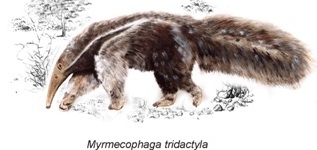
Oso hormiguero
Categoría nacional 2012: VU A2c+3c
Categoría nacional 1997 y 2000: EN A1c+2cd; B2cd
Categoría global UICN 2011: VU A2c
Comentarios: En la República Argentina, la extensión de presencia (EOO) de esta especie se redujo en los últimos 40 años en aproximadamente
un 45%. A partir de la reducción de la EOO y de la calidad de hábitat, para ese lapso se estima una reducción de la población superior al 30%. Las principales amenazas (reducción de calidad de hábitat, fragmentación y pérdida de hábitat) no han cesado. Es indispensable obtener datos de poblaciones silvestres para verifi car su
estado de conservación.
ORDEN PRIMATES
I Agostini et al.
FAMILIA: Atelidae
Alouatta caraya (Humboldt)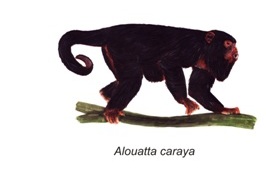
Mono aullador negro, carayá-hú
Categoría Nacional 2012: VU A4cd; C2a(i)
Categoría Nacional 1997 y 2000: LC
Categoría Global UICN 2011: LC
Comentarios: Es la especie del genero Alouatta que se encuentra más
al sur en su distribución (Brown y Zunino, 1994; Di Fiore y Campbell,
2007). Se extiende por Paraguay, sur de Brasil, norte y este de Bolivia
y noreste de Argentina. En la Argentina se distribuye en las provincias
de Misiones, Corrientes, este de Chaco y Formosa, y en el noreste de
Santa Fe en las riberas e islas del río Paraná. La densidad estimada para
diferentes áreas es 104 ind/km2 en los bosques en galería fragmentados
del noroeste de Corrientes (27o30’S, 58 o41’O, Zunino et al., 2007); entre
12 y 110 individuos/km2 en las provincias de Chaco y Formosa (Arditi y
Placci, 1990; Brown y Zunino, 1994; Dvoskin et al., 2004; Juárez et al.,
2005); entre 280 y 330 individuos/km2 en las selvas de inundación sobre
el río Parana medio en la provincia del Chaco (27 o20’S, 58 o40’O, Rumiz
1990; Kowalewski y Zunino, 2004); y < 1 ind/km2 en la selva paranaense
—PN Iguazú— (Zunino et al., 2001). Gran parte de sus poblaciones se
encuentran fuera de las áreas protegidas, donde los bosques que habita
enfrentan cambios en la composición, fragmentación y reducciones en
su extensión debido a la actividad humana (expansión de las fronteras
agropecuarias, agroindustriales y urbanas). Las tasas anuales de
deforestación para el período 2002-2006, en el área de presencia, son
las siguientes: Formosa -0.25%, Santa Fe -0.54% (Unidad de manejo
del sistema de evaluación forestal, 2008), Chaco -0.75% y Misiones
-1.32% (Unidad de Manejo del Sistema de Evaluación Forestal, datos
Fichas corr.indd 81 10/10/2012 14:35:57
82 Libro Rojo de Mamíferos Amenazados de la Argentina
sin publicar). Para la provincia de Corrientes no hay datos ofi ciales desde
1998. Además la especie es víctima de la explotación mediante el
tráfi co ilegal de fauna aunque se desconocen los números específi cos
(Bertonatti, 1995; Zunino y Kowalewski, 2008). Estudios recientes con
marcadores microsatélites polimórfi cos sugieren que la fragmentación
del hábitat disminuye la probabilidad de migración y concluye que, si
las restricciones migratorias continúan o aumentan, en poco tiempo
se puede esperar encontrar un aislamiento permanente que conduzca
a una alta endogamia en los grupos (Oklander et al., 2006; Oklander,
2007). En el caso de las selvas de inundación localizadas sobre las
islas del río Paraná la situación es favorable para estos aulladores. Las
densidades son altas y prácticamente no enfrentan ninguna amenaza
salvo las inundaciones extraordinarias que históricamente no diezmaron
las poblaciones isleñas. En las tierras fi rmes de Chaco, Corrientes
y Formosa enfrentan problemas relacionados con la deforestación y
alteración de paisaje. En la provincia de Misiones, la población ha sido
severamente diezmada por una epidemia de fi ebre amarilla durante el
2008 (Holzmann et al., datos no publicados).
ORDEN CARNIVORA
FAMILIA: Canidae
Chrysocyon brachyurus (Illiger)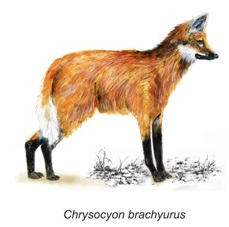
Aguará guazú, lobo de crín
L. Soler
Categoría Nacional 2012: EN A1acde+2ce; C2a
Categoría Nacional 2000: EN A1ace+2ce, C2a
Categoría Nacional 1997: VU A1acde, B1+2abcd; C2a
Categoría Global UICN 2011: NT
Comentarios: En el nordeste el cuero de aguará guazú y algunas de
sus partes corporales son utilizadas en carácter de remedios, paliativos
o preventivos; también culturales. Por eso se considera el ítem d. El
porcentaje de la población global que ocurre en la Argentina es de 4%,
obtenido a partir de los valores de abundancia para el país, estimados
en el I Encuentro Internacional de Serra de Canastra (2005). Los datos
del modelo pueden consultarse en Cunha de Paula et al. (2008).
CURSOS AVANZADOS 2012
Biología de la Conservación 2012/ Conservation Biology 2012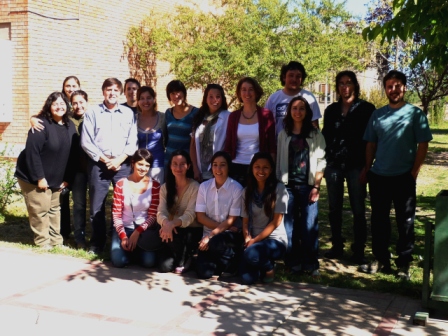 [44]
[44]
Docentes: Ricardo A. Ojeda (Coordinador), Solana Tabeni, Agustina A. Ojeda, Fernanda Cuevas (IADIZA-CONICET) y Mariella Superina (IMBECU-CONICET),CCT Mendoza, Argentina.
Fecha: 15 al 20 de Octubre de 2012
DIVERSITY AND DISTRIBUTION OF SMALL MAMMALS IN THE SOUTH AMERICAN DRY ANDES
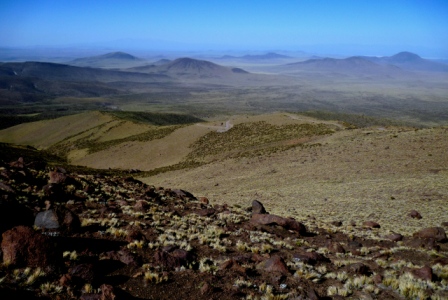
The Andean mountain range has played an important role in the evolution of South American biota.However, there is little understanding of the patterns of species diversity across latitudinal and altitudinal gradients.
In this paper, we examine the diversity of small mammals along the South Central Dry Andes (SCDA) within the
framework of two contrasting hypotheses: (a) species richness decreases with increasing elevation and latitude; and
(b) species richness peaks at altitudinal midpoints (mid-domain).We explore the composition of the species pool,
the impact of species–area relationships and the Rapoport effect (i.e. size of geographic ranges) along latitudinal and
elevational gradients. First, we constructed a database of SCDA small mammals. Then, species richness patterns
were analysed through generalized models, and species–area relationships were assessed by log–log regressions; the
curvilinear method (c = S/Az) was use to compute richness corrected by area size. Lastly, the Rapoport effect was
evaluated using the midpoint method.

Our results show: (1) a richness of 67 small mammals along the SCDA, of
which 36 are endemic; (2) a hump-shaped pattern in species richness along elevation and latitudinal gradients; (3)
a species–area relationship for both gradients; (4) endemic species corrected by area present a strong and positive
relationship with elevation; (5) a Rapoport effect for the latitudinal ranges, but no effect across the elevational
gradient; and (6) a major species turnover between 28° and 30° south latitude. This is the first study quantifying
the diversity of small mammals encompassing the central Andean region. Overall, our macrogeographic analysis
supports the previously postulated role of the Andes in the diversification of small mammals (i.e. in situ cladogenesis)
and highlights some basic attributes (i.e. anatomy of geographic ranges; species–area relationships) when
considering the consequences of climate change on biodiversity conservation of mountain ecosystems.
(Agustina Novillo y Ricardo Ojeda, Austral Ecology 2011)pdf
Efectos de las actividades humanas sobre la diversidad funcional de los mamíferos de zonas áridas[45]
Descubrieron un nuevo roedor sin dientes molariformes
Dr Kevin Rowe, from Museum Victoria in Australia, a member of the discovery team, said: 'There are more than 2,200 rodent species in the world and until this discovery all had molars in the back of their mouth and incisors at the front.This is an example of how species, when faced with a new ecological opportunity, in this case an abundance of earthworms, can evolve the loss of traits that were wildly successful in previous circumstances.[46]
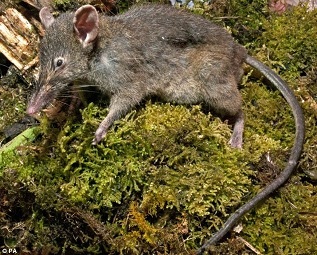
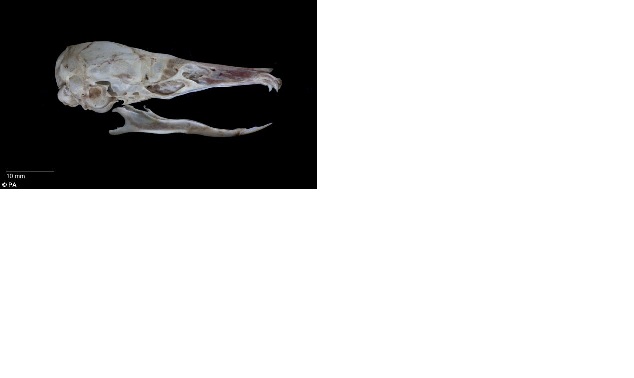
NUBES DE POLVO DE SAL SOBRE MAR CHIQUITA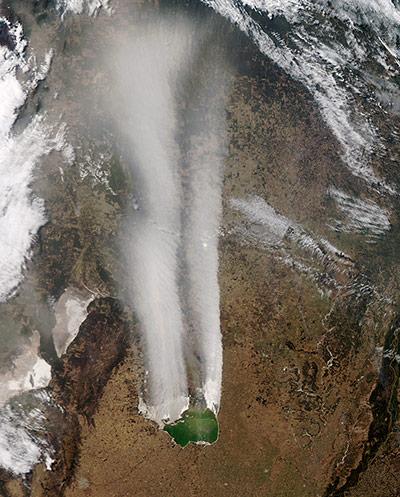 Nubes_sal_Mar_Chiquita.doc
Nubes_sal_Mar_Chiquita.doc
Reflexiones en torno a la biodiversidad[47]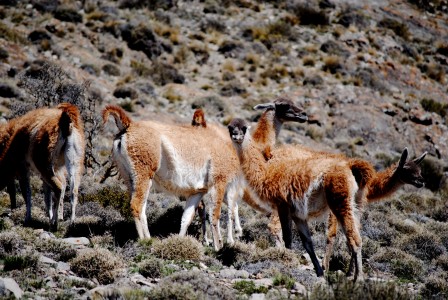
LA CONVERGENCIA QUE FALTABA![48]
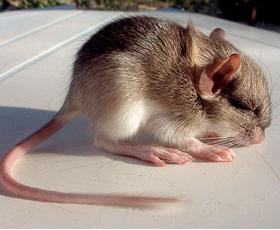
La deforestación en Córdoba[49]
El desmonte del "impenetrable" chaqueño[50]
Ecosistema andino, biodiversidad y cambio climático[51]
Resiliencia del desierto al pastoreo[52]
La invasión de los castores[53]
Estado de la población mundial 2011[54]
LAS TIERRAS SECAS HACIA RIO+20: LA PERSPECTIVA DESDE AMERICA LATINA Y EL CARIBE
[[Media:doc
Ordenamiento de bosques nativos
pdf
Vicuña dando a luz en el Parque Nacional de San Guillermo, San Juan, Argentina
[55]
Mendoza y un nuevo Parque Provincial: El Cordón del Plata[56]
La fragilidad del pedemonte mendocino[57]
La conservación del guanaco y otras especies
[58]
NUEVA PUBLICACIÓN ELECTRÓNICA DE CIENCIAS NATURALES[[59]
ÑACUÑAN: 50 años de la Reserva del Hombre y la Biósfera
pdf
Presiones selectivas, convergencia evolutiva y coexistencia de pequeños mamíferos del desierto
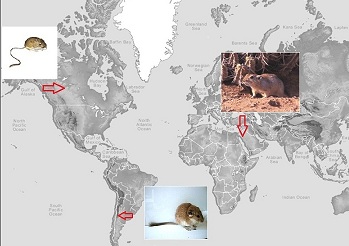
El ecosistema del desierto constituye un escenario ideal donde poner a prueba algunos de los aspectos relevantes de la teoría evolutivo-ecológica. Entre estos, la homoplasia por evolución convergente es uno de los resultados que presentan organismos de distintos linajes y separados unos de otros, ante presiones selectivas similares.
Entender, por un lado, aquellos factores que operan como fuerzas de selección sobre los organismos del desierto del Monte (ej. baja productividad, precipitaciones escasas, otros), y consecuente adaptación, y por otro, la diversidad y mecanismos de coexistencia en una comunidad conformada por diversos linajes de mamíferos, forma parte de las investigaciones que desarrollamos en el GiB con un enfoque integrativo.
La aproximación integral desde distintas disciplinas (biogeografía, ecofisiología, ecología, genética, comportamiento) nos permite un mejor entendimiento sobre la composición, organización, funcionamiento y dinámica de la diversidad biológica de los desiertos, sus semejanzas y diferencias con otros desiertos del mundo, y por otro lado, una mayor robustez en las bases para la planificación de su conservación ante las múltiples y crecientes amenazas (Ricardo A. Ojeda, 2da Reunión Conjunta de Sociedades de Biología de la República Argentina 17-19 Agosto, 2011, San Juan; parcialmente financiado por PIP- CONICET 2884, 5944, 0325, y PICT Agencia 11768, 0455.)
INVESTIGADORES VISITANTES/GUEST RESEARCHERS
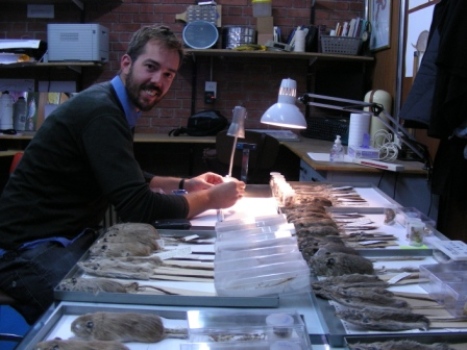
En el mes de Agosto recibimos la visita del Dr Nathan Upham (McMaster University, Hamilton, Ontario, CANADA; Integrative Research Center (Mammals)Field Museum of Natural History, Chigaco. USA ). El motivo de la misma fue intercambiar ideas para el desarrollo de una propuesta de investigación colaborativa sobre evolución de roedores octodóntidos de tierras áridas. La agencia a financiar (parcialmente) el proyecto sería la National Science Foundation (NSF). Durante su estadía aprovechó para conocer y analizar ejemplares de la Colección Mastozoológica IADIZA, y presentar resultados de sus investigaciones sobre radiación adaptativa y constricciones ecológicas en roedores caviomorfos, en el marco de los Seminarios IADIZA-IANIGLA.
 Durante gran parte del año estará con nosotros Raphaël Arlettaz, quien realiza su período sabático en nuestro instituto.
Raphael es investigador en la Universidad de Berna, Suiza, y dirige el grupo de Biología de la conservación y restauración
ecológica (http://www.cb.iee.unibe.ch/) en el Instituto de Ecología y Evolución (http://www.iee.unibe.ch/content/index_eng.html).
Sus intereses son variados, desde plantas a vertebrados, con foco en ecosistemas de montaña y agroecosistemas (incluyendo viñedos) (http://www.iee.unibe.ch/cb/content/about_us/staff/arlettaz/index_eng.html).
Raphael habla francés, alemán, inglés, italiano y comenzando ahora con español, y está interesado en interactuar e intercambiar ideas
y experiencias con quienes compartan intereses similares.
Para quienes deseen contactarlo su mail es: raphael.arlettaz@iee.unibe.ch
Durante gran parte del año estará con nosotros Raphaël Arlettaz, quien realiza su período sabático en nuestro instituto.
Raphael es investigador en la Universidad de Berna, Suiza, y dirige el grupo de Biología de la conservación y restauración
ecológica (http://www.cb.iee.unibe.ch/) en el Instituto de Ecología y Evolución (http://www.iee.unibe.ch/content/index_eng.html).
Sus intereses son variados, desde plantas a vertebrados, con foco en ecosistemas de montaña y agroecosistemas (incluyendo viñedos) (http://www.iee.unibe.ch/cb/content/about_us/staff/arlettaz/index_eng.html).
Raphael habla francés, alemán, inglés, italiano y comenzando ahora con español, y está interesado en interactuar e intercambiar ideas
y experiencias con quienes compartan intereses similares.
Para quienes deseen contactarlo su mail es: raphael.arlettaz@iee.unibe.ch
 Durante el mes de noviembre, hasta los primeros dias de diciembre, nos visita Toni Koren, de la Universidad de Primorska, Science and Research Center Koper,Institute for biodiversity Studies, Eslovenia. Tony esta desarrollando su investigación doctoral en Filogeografía y ecología poblacional de Glis glis (Rodentia) en las islas del Mar Adriático.
Su visita se enmarca en el Programa de Cooperación Científico-Tecnológico entre el MINCyT (Argentina) y Ministry of Higher Education, Science and Technology de la República de Eslovenia (MHEST) referido a la ecología trófica del Lirón grís, Glis glis, en diferentes hábitats.
Durante el mes de noviembre, hasta los primeros dias de diciembre, nos visita Toni Koren, de la Universidad de Primorska, Science and Research Center Koper,Institute for biodiversity Studies, Eslovenia. Tony esta desarrollando su investigación doctoral en Filogeografía y ecología poblacional de Glis glis (Rodentia) en las islas del Mar Adriático.
Su visita se enmarca en el Programa de Cooperación Científico-Tecnológico entre el MINCyT (Argentina) y Ministry of Higher Education, Science and Technology de la República de Eslovenia (MHEST) referido a la ecología trófica del Lirón grís, Glis glis, en diferentes hábitats.
Durante el mes de setiembre, Jane Bowles y Paul Handford (University of Western Ontario, London, Canada) estuvieron recorriendo junto a Ricardo Ojeda las grandes ecorregiones del noroeste de Argentina: Monte, Puna, Selva de Yungas y Chaco.
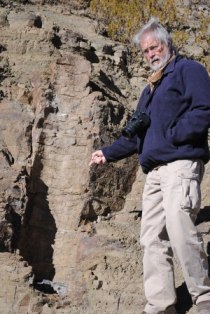

Michael Wisdom, Research Biologist with the Pacific Northwest Research Station of the United States Forest Service, has been awarded a Fulbright Scholar grant to conduct research and teach at the Institute for Aridlands Research, National Council for Science and Technology, Mendoza, Argentina, from September to December 2011.
Dr. Wisdom has an extensive background in wildlife research on ungulates, species of conservation concern, wildlife-landscape relationships, and methods to evaluate landscape conditions for vertebrates. He has authored over 120 publications in scientific journals and given over 400 invited presentations at professional conferences and symposia.
Dr. Wisdom will co-teach a graduate course on animal resource selection at the University of Cuyo with CONICET scientist Dr. Solana Tabeni, and with scientists Mary Rowland and Ryan Nielson from the United States. Dr. Wisdom also will conduct research on two native ungulate species, the taruka and the guanaco, in collaboration with CONICET scientists Dr. Ricardo Ojeda and Dr. Andres Novaro.
The graduate course on animal resource selection will be taught in November at the CONICET Research Center CCT in Mendoza [60]. Course content will address a wide spectrum of material on methods of analyzing animal movements and habitat use for research and management application. New research on the taruka, a small, rare deer species that occupies high-elevation grasslands in the Andes of northwestern Argentina, will be initiated by Wisdom and Ojeda with biology student Gusatavo Marás of the University of Salta. No formal research on the species has been conducted in Argentina, and only a few hundred individuals are thought to exist in the entire country. The research is expected to provide essential knowledge for management of this national monument species to maintain viable populations. New research on guanacos, which occupy arid and semi-arid grasslands and shrublands of Argentina, will be initiated by Wisdom and Novaro to develop, validate, and apply resource selection models for evaluation of the species’ response to a wide variety of human activities occurring on landscapes of Mendoza and Neuquen Provinces. Wisdom and Novaro will work on the guanaco research with Ph.D. students Ramiro Ovejero[[61]] and Natalia Radovani as part of the two students’ proposed post-doctoral appointments with CONICET.

Matt Hill will be visiting the GiB-IADIZA from December 5 to 16. He is a PhD candidate at the University of Melbourne, Australia. His research focuses on building a predictive framework to assess climate change impacts on pest invertebrates of grains growing. The main candidate species of this research is the redlegged earth mite (Halotydeus destructor), an invasive species from South Africa that is widespread across southern Australian agricultural regions. Successful prediction of future affects of climate change will require an integrated approach combining of species distribution modelling (correlative and mechanistic models) with physiological (thermal tolerance) traits and phylogeographic (microsatellites) information, to be able to inform management decisions.
VISITAS CORTAS DE INVESTIGACION EN EL GiB
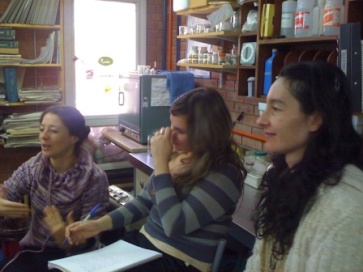
A partir de Mayo, y durante todo el año, el Grupo de Investigaciones de la Biodiversidad (GiB-IADIZA, CONICET) invita a desarrollar un período de capacitación en la práctica de la actividad científica. El mismo esta dirigido a estudiantes egresados
o del último año de la carrera de biología.
El Programa de actividades es intensivo,estructurado y orientado a introducir y familiarizarlos con la actividad
investigativa profesional a través de formulación de proyectos, lectura, discusión y presentación de trabajos
relacionados con biogeografía, ecología, sistemática, filogeografía, ecofisiología y conservación de mamíferos.
El Programa busca cubrir los aspectos señalados y por otro lado satisfacer las expectativas e inclinaciones expresadas
con anterioridad por los postulantes.
Por lo general el tiempo de las visitas es de una semana (equivalente a 40 hs). Desde el GiB- IADIZA se extenderá
un certificado de lo desarrollado durante el período. El GiB no cubre ningún gasto de estadía.
Durante el período se orientará asimismo sobre el funcionamiento del sistema científico y oportunidades para
el desempeño profesional.
Los interesados deberán remitir una breve carta vía e-mail, donde expresen su interés, perfil
(curriculum vitae) y fechas potenciales a: rojeda@mendoza-conicet.gov.ar
Visitas[[62]]
Floración Caña Colihue y ratadas[63]
Serpientes de Mendoza[64]
Invasiones biológicas: Nido de ratas y control ambiental[65]
EL CONICET DIALOGA[66]
DIVULGACION CIENTIFICA, UNIVERSIDAD DE LA MATANZA[[67]]
El establecimiento del conejo europeo en el norte de la Provincia de Mendoza
pdf
Disminución de especies hacia el sur de la Selva de las Yungas[68]
LA LUPA: Colección fueguina de divulgación científica[69]
REVISTA DE DIVULGACION CIENTIFICA DEL NOROESTE ARGENTINO[70]
Nuevo Parque de la región cordillerana de Mendoza[71]
Roedores sudamericanos y adaptaciones al desierto[72]
Mamíferos de Ñacuñan[[73]]
LA CHINCHILLA EN ARGENTINA: NOVEDADES[74]
Los flamencos de Llancanelo[75]
Minería de montaña y sus consecuencias[76]
La caza de mamiferos en Mendoza[77]
Un nuevo mamífero para Mendoza[78]
Matanza legal de pumas en Patagonia[79]
Estado del ambiente en América del Sur[80]
Biodiversidad y Bienestar Humano en América Latina y el Caribe [81]
|
<p style="text-align:center; font-size: 150%; line-height: 95%">ENERGY AND LIMITS OF GROWTH
Media:Energy_and_limits_of_growth_Brown_et_al.pdf
|
|
Physical and economic consequences of climate
change in Europe
[82]
|
|
BIOGEOGRAFIA MARINA
[[83]
|
|
ATLAS OF BIODIVERSITY RISK
[[84]][85]
|
|
Asuntos críticos ambientales
[[86]
|
|
Propagación de la fiebre del Dengue
[[87]
|
|
Las Áreas protegidas como observatorios del Cambio Global
[[88]
|
|
Consequences of being rich: wealth and population are key drivers of invasive species in Europe
[[89]]
|
|
Las Yungas y Bosques nubosos en peligro
[[90]]
|
|
Small mammal diversity loss in response to Late Pleistocene climate change
[91]
|
|
Laguna de Mar Chiquita y tormentas de sal
Nubes_sal_Mar_Chiquita.doc
|
|
MAMMALS OF THE MONTE DESERT: FROM REGIONAL TO LOCAL ASSEMBLAGES
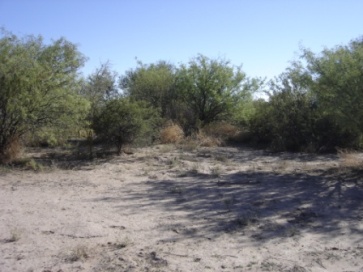
Much of South America consists of diverse arid and semiarid regions, characterized by high mammal endemism as a result of a complex interplay between site and lineage histories. In this review, we summarize and highlight several biogeographical and ecological features of the small mammals of South America drylands, with special focus on the Monte Desert biome. We provide information on population characteristics, community structure, food and habitat use, and responses to disturbances. Major findings at different scales include: the distinctiveness and high species turnover across South American drylands and Monte Desert ecoregions; synchronous population fluctuations with high variability between years; herbivory and omnivory as dominant trophic strategies; community structure organized through habitat and food segregation, and the importance of a landscape mosaic of grazed and ungrazed areas for maintenance of small and medium sized mammal diversity. (Ricardo Ojeda, Solana Tabeni and Valeria Corbalán, 2011, Jour Mamm.
pdf
|
|
Declinación de la diversidad de mamíferos en la Selva de Yungas / Mammals Diversity decline in the Yungas forest
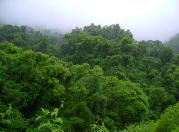
La extensión más austral de la selva tropical Andina y Amazónica terminan a modo de archipiélago dentro de una matriz árida a semiárida en el noroeste de Argentina. Analizamos el patrón de diversidad de especies a lo largo de esta extensión de selvas montanas (Yungas) entre los 22° a 29° S . Nuestro análisis incluye 38 especies de mamíferos selváticos. Estimamos los bordes de los rangos geográficos y mediante un modelo nulo derivamos los límites de confianza para la riqueza de especies y rangos terminales esperados dentro de bandas de 30’. Analizamos el número de rangos terminales y su relación con los atributos ecológicos (macronichos) de las especies. Encontramos un decrecimiento de las especies exclusivas de selva de norte a sur, y ninguna de ellas alcanza el “borde” de la “península” selvática. Esto contrasta con los registros de mamíferos no exclusivos de selva. Los rangos geográficos terminales se agrupan entre los 23° 30’ - 24° 00’ S, indicando un decrecimiento no azaroso de las especies. La correlación entre atributos de las especies (macronichos) y rangos geográficos terminales, sugiere que solo aquellas con vulnerabilida baja y tamaño corporal grande, son capaces de alcanzar una distribución mas extendida a lo largo de las Yungas. Sugerimos que la observada caida de especies es el resultado de la interacción entre un decrecimiento general de la calidad de hábitats de selva en los extremos de distribución, los atributos de las especies y el estado de las poblaciones tropicales en los bordes de distribución. Este estudio tiene implicancias para la conservación de ecosistemas tropicales en los extremos de su distribución (R.A. Ojeda[[92]] R.M. Barquez, J. Stadler y R.Brandl. 2008. Decline of mammal species diversity along a tropical forest. Biotropica, 40:525-521)
[93]
|
|
Asuntos críticos: nuevas fronteras [94]|-
|
|
Revista Latinoamericana de conservación
[95]|-
|
|
THERYA, nueva revista Mexicana de mastozoología [96]|-
|
|
CONSERVATION LETTERS, acceso libre 2010 [97]|-
|
|
Biodiversidad en América Latina y el Caribe [98]|-
|
|
Invertir en islas para salvar mas especies/ Invest in islands to save most species [99]|-
|
|
Complete Primate Skeleton from the Middle Eocene of Messel in Germany: Morphology and Paleobiology [100]|-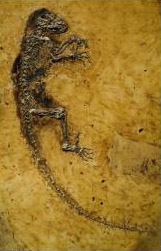
|
|
La 'resurrección' de la nutria en la península ibérica [101]|
|
|
Un mosquito pone en peligro a las islas Galápagos [102]|
|
|
Badly bat disease spreading fast, scientists warn lawmakers BAt disease spreading fast
|
|
Evolución: asuntos críticos
[[103]]
|
|
Ciencia, evolución y creacionismo [104]
|
|
Ecosistemas nuevos [105]
|
|
Asuntos críticos: Educación
[[106]]
|
|
Reflexiones en torno al sistema científico argentino
Media:Reflexiones_en_torno_al_sistema_científico_argentino.doc
|
|
La Lista Roja de UICN
[[107]]
|
SITIOS en la web y Facebook
IADIZA-CONICET[108]
CONICET DIALOGA[109]
RED LATINOAMERICANA PARA LA CONSERVACION DE LOS MURCIELAGOS[110]
INTERNATIONAL BIOGEOGRAPHY[111]
IADIZA-CONICET[112]
ESPECIES EXOTICAS DE ARGENTINA[113]
SAREM Y SU HISTORIA [114]
ZOOARQUEOLOGIA Y TAFONOMIA DE ZONAS ARIDAS [115]
DIVERSUS[116]
Asociación Argentina de Ecología[117]
EL GRAN CHACO[118]
MADRI+D[119]
EXPLORAsitio de actualización y educación docente en las ciencias en el mundo contemporaneo[120]
EDUCACION, ARTE y CIENCIA en MENDOZA[121]
ECOLIBRERIA[122]
Biodiversity Indicators 2010[123]
National Ecological Observatory Network(USA)[124]
Ranking scientific journals[125]
Global Invasive Species Programme[126]
Base de Datos de Especies Invasoras en Argentina[127]
Encyclopedia of life[128]
IBOL Newsletter [129]
Biodiversity Heritage Library[130]
ECOSISTEMAS[131]
Asociacion Argentina de Ecologia del Paisaje[132]
Centro Internacional de Ecología Tropical[133]
2010 International Year of Biodiversity [134]
COUNTDOWN 2010[135]
Econoticias de América Latina </p>[136]
ECOLOGICAL INTERNET [137]
Science daily [138]
ABC Science[139]
Environmental News Network [140]
Biodiversidad América Latina [141]
IUCN[142]
ECO 21[143]
World Science[http://www.world-science.net
Nature News[144]
DARWIN 200[145]
|
MASTOZOOLOGIA NEOTROPICAL 
[146]
|
|
ZOOTAXA-MAMMALIA
[147]
|
|
DIA INTERNACIONAL DE LA DIVERSIDAD BIOLÓGICA 22 DE MAYO
|
|
|
|
|
INVASIONES BIOLOGICAS: MAMIFEROS EXOTICOS/ BIOLOGICAL INVASIONS: EXOTIC MAMMALS
Las invasiones biológicas, deforestación, fragmentación de hábitats, cambio climático y comercio de vida silvestre, son algunos de los factores responsables por la acelerada pérdida de biodiversidad. El Grupo de investigaciones de la Biodiversidad dirigido por Ricardo Ojeda[[148]], está abocado al módulo de invasiones biológicas como parte del proyecto ALARM (6to marco Unión Europea), y en un artículo reciente junto a Agustina Novillo sintetizaron el panorama actual de los mamíferos exóticos de Argentina, sus efectos sobre los ecosistemas y atributos correlacionados con el éxito de las invasiones.
Agustina Novillo[[149]] y Ricardo Ojeda destacan que los mamíferos introducidos representan en Sud América el 20 % de las introducciones de mamíferos a nivel mundial, y que unas 18 especies mantienen poblaciones en estado silvestre en Argentina[[150]]. Las introducciones se localizan mayormente en ecorregiones templadas, entre los 34° y 55° de latitud, área donde alcanzan las mayores densidades. El artículo publicado online en una reconocida revista abocada a la problemática de las invasiones biologicas (Jour Biol Invasions[151]
compila los mamíferos exóticos de Argentina y sus efectos. Desde los castores en Tierra del Fuego, que se comportan como “ingenieros del ecosistema”, construyendo embalses y cambiando la dinámica del ecosistema del bosque de Nothofagus, a una de las especies “mas peligrosas” de los invasores como es el jabalí, con amplio rango geográfico y colonizador reciente en el Desierto del Monte[152].
Según el artículo de A.Novillo y R.Ojeda, los mamíferos exóticos ocupan en Argentina ecoregiones similares a sus distribuciones originales (ej. en Eurasia), y mas aún, gran parte de ellos parecen haber experimentado cierta “liberación ecológica” al expandir sus rangos geográficos a hábitats “nuevos”, en comparación a los de su distribución original. Las especies con alto potencial de invasividad corresponden al jabalí, cabra, liebre europea y ratas del “viejo mundo”, y atribuyen esta cualidad de “buenos” invasores a características como: dieta amplia, gran masa corporal, asociación con ambientes urbanos antropizados, alta capacidad de dispersión, alta tasa reproductiva, concordancia climática (ej ecorregiones similares), entre otras.
Mas allá de los impactos registrados y potenciales, los autores consideran que los mamíferos exóticos ofrecen una buena oportunidad para entender la dinámica de las invasiones biológicas mediante investigaciones ecológicas detalladas y metodologías apropiadas.
pdf
|
|



